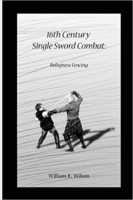“Around the same time another invention increased the popularity of swordplay even further—what Marshall McLuhan has called "the making of typographical man." A cluster of innovations, including movable metal type, oil-based ink, and the wooden handpress, revolutionized learning. For the first time those who taught fencing could have their ideas printed and disseminated. The age of the master had arrived”. [1]
Trying to assess a ‘Fechtbuch’ is challenging when one doesn’t know much about the particular discipline being taught in the tome. But then again, 20 years ago, when HEMA was a fledgling study, enterprising individuals picked up medieval manuscripts and renaissance writings and using trial and error, came up with a modern interpretation of HEMA as most of us understand it today.
It is in this spirit that I review William E. Wilson’s ‘16th Century Single Sword Combat’. The work is not so much a stand-alone fight book as it is Wilsons’ depiction of some elements of the Dardi School ‘system of fence’ – elements of other masters fight books if you will.
That said, Mr. Wilson cautions “I cannot stress enough that it is very difficult to learn a martial art from a book. I advise you to find a qualified instructor. Small nuances of execution of technique are almost impossible to convey in a book …” [2]
The book starts traditionally, with a historical description of how the Dardi School developed, who were its practitioners and with what style of swords (spada de filo). Wilson emphasizes that this form of north Italian swordplay was born from the (then) real-world requirements for a man to be able to use a sword in war or duelling, and that the study of 16th C swordplay is a martial art; not an academic curiosity or hobby dalliance. And he gently enjoins us to approach our studies accordingly.
Now strengthened by historical back ground and proper attitude, we get into the instructional portion of the book: holding the sword, stance, footwork, measure and tempo, guards, cuts and thrusts, and parries.
The chapters on guards and parries are truly effective in presentation and ease of use. Guards are described by at least two masters and supported by front and side photography … and a historical illustration. A parry description starts with a description of how is it to be used, supported with a description of its employment and supported by a photo. I found it very easy to understand the theory of what guard or action was being described and then replicated them – and thus, this book was an unqualified success in acquainting me to the basic of the Dardi School system.
Wilson ends with a wonderful ‘Newbies’ Guide to Surviving a Duel’ … his interpretation on one Dardi master’s contention that if you could master two guards, a parry and an attack; that you had a fighting chance of surviving an impromptu meeting of blades. And one could do this in thirty days (no word however on whether you had to take instruction for an hour, eight hours or 12 hours daily). The master was not advocating a ‘bot secret’ or single tricks, but encouraged one to master four or five complimentary elements of the system.
My concerns with ‘16th Century Single Sword Combat’ are minor at most.
A lot of the small black and white photography and illustrations are ‘muddy’ in quality, the finer details seem smudged … including sword blades fading into the background body of the wielder.
I have a quibble with the other-wise excellent depictions of the ‘parries’ (pages 104 to 135); it would be easier referencing if the master and student photos were placed directly under the text description of each of their actions, vice being reversed.
Wilson recommends that the sword player read the book entirely, and then go back and study intensively the chapters. The chapters are supported by a generous selection of quotes from original fight books, sometimes too much so. If I may; as mentioned above, the guards and parries pages are supported by two, sometimes three references; the subtle differences of which can be confusing. For the “beginner” studying this book, I recommend choosing one historical master from those offered, and concentrate on his instruction while you learn the basics of Dardi School swordplay.
“Sir William Hope of Balconie, … accomplished swordsman, equestrian and author, died in 1729 of a chill caught after over-exertion in dancing. Despite his learned observations on duelling, he admits in his New Method of Fencing that, in all his life, he was never called upon to practice what he preached. For all that, his books were received with such approval that they were regarded as the unrivalled authorities on their subject for more than fifty years.” [3]
Last, who are you Mr Wilson? More importantly, why should I choose your book to as an authority to expose me to north Italian swordplay? For all authors, it is essential that the reader understand your qualifications, expertise and yes, perhaps your reasons for writing a reference work – and why I should trust your guidance. I work hard for my money. Convince me that your interpretation of HEMA, your book, is a good investment.
I found 16th Century Single Sword Combat an excellent introduction to Bolognese fencing – a joy enhanced by the very modest cost of this manual. Even if your preferred swordplay style is with another weapon, Wilsons’ effort deserves space on your bookshelf, if only as an item of professional interest.
Work Cited
1. Cohen, Richard. By the Sword: Gladiators, Musketeers, Samurai Warriors, Swashbucklers and Olympic Champions. New York NY: Modern Library, 2008. P.21
2. Wilson, William E. 16th Century Single Sword Combat – Bolognese Fencing. San Bernardino CA: William E. Wilson, 2014. P.7
3. Aylward, J.D. The English Master at Arms from the 12th Century to the Twentieth Century. London UK: Routledge & Kegan Paul, 1956. P.160
